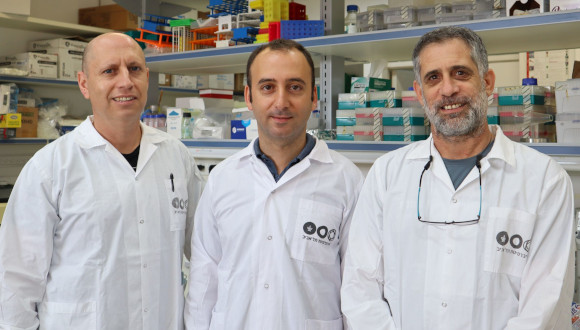TAU research finds British variant of COVID-19 is 45% more contagious than the original virus

Study based on data from 300,000 tests for COVID-19
Support this researchA new study from Tel Aviv University (TAU) found that the British variant of the COVID-19 virus (B.1.1.7) is 45% more contagious than the original virus. The researchers relied on data from about 300,000 PCR tests for COVID-19 obtained from the COVID-19 testing lab established by TAU in collaboration with the Electra Group.
The new study was conducted by Professors Ariel Munitz and Moti Gerlitz of the Department of Clinical Microbiology and Immunology at TAU’s Sackler Faculty of Medicine. Their collaborators included Dr. Dan Yamin and PhD student Matan Yechezkel from the Laboratory for Epidemic Modeling and Analysis (LEMA) at TAU’s Department of Industrial Engineering. The study’s results were published in Cell Reports Medicine.
The Electra-TAU laboratory was established in March 2020, right after the outbreak of the first wave of the pandemic in Israel. To date, it has analyzed hundreds of thousands of tests from all over the country from public drive-in test facilities as well as programs targeting specific populations such as “Shield for Fathers and Mothers,” which routinely ran tests in at-risk hotspots like retirement homes.
“We use a kit that tests for three different viral genes,” Professor Munitz says. “In the British variant, also known as B.1.1.7, one of these genes, the S gene, has been erased by the mutation. Consequently, we were able to track the spread of the variant even without genetic sequencing.”
According to Professor Munitz, the data from the lab shows that the spread of the British variant was very rapid. On December 24, 2020, only 5% of the positive results were attributed to the British variant. Just six weeks later, in January 2021, this variant was responsible for 90% of COVID-19 cases in Israel. The current figure is about 99.5%.
“To explain this dramatic increase, we compared the basic reproduction number — the ‘R number’ — of the original SARS-CoV-2 virus with the R number of the British variant,” Professor Munitz explains. “In other words, we asked how many people, on the average, contract the disease from every person who has either variant? We found that the British variant is 45% — almost 1.5 times — more contagious.”
In the second stage of the study, the researchers segmented contagion by age groups. The results indicated that the turning point for the 60+ population occurred two weeks after 50% of Israel’s 60+ population received their first vaccine shot.
“Until January we saw a linear dependence of almost 100% between the different age groups in new cases per 1,000 people,” says Dr. Yamin. “Two weeks after 50% of the 60+ population received the first dose of the vaccine this graph broke sharply and significantly. During January, a dramatic drop was observed in the number of new cases in the 60+ group, alongside a continued rise in the rest of the population.
“Simply put, since more than 90% of those who died from Covid-19 were over 60, we can say that the vaccine saved hundreds of lives, even in the short run.”
The new study also proves that active monitoring of at-risk populations works, the researchers report. “There is a threshold value for determining whether a specific test is positive or negative for the virus, with a lower value indicating a higher viral load,” says Professor Munitz. “When we compared the threshold values of the different genes in 60+ residents of retirement homes with the values measured in 60+ persons in the general population, we saw significantly higher values in the retirement homes. This means that the viral load in retirement homes was lower compared to the rest of the population.
“Since the residents of retirement homes are routinely tested compared to others at less risk, we conclude that constant monitoring of at-risk populations is a method that works,” Professor Munitz says. “It is important to emphasize that the relatively low viral load was found in retirement homes despite the fact that the British variant had already begun to spread in all populations. Consequently, we show that monitoring retirement homes, together with vaccination that gives precedence to vulnerable populations, prevent illness and mortality.”
“Due to crowded conditions, large households, and age distribution in the Israeli population, the coronavirus had a more favorable environment for spreading in Israel compared to most Western countries,” Dr. Yemin concludes. “Our message to the world is that if with our problematic starting point a distinct decline was identified, other Western countries can certainly expect the curve to break despite the high contagion of the British variant, with a dramatic drop in severe cases following the vaccination of 50% of the older population, alongside targeted testing at risk epicenters.”